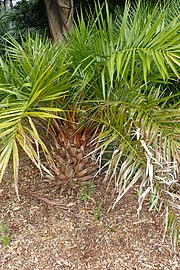Phoenix (plant)

Phoenix is a genus of 14 species of palms, native to an area starting from the Canary Islands in the west, across northern and central Africa, to the extreme southeast of Europe (Crete), and continuing throughout southern Asia from Turkey east to southern China and Malaysia.[3] The diverse habitats they occupy include swamps, deserts, and mangrove sea coasts. Most Phoenix species originate in semiarid regions, but usually occur near high groundwater levels, rivers, or springs. The genus is unusual among members of subfamily Coryphoideae in having pinnate, rather than palmate leaves; tribe Caryoteae also have pinnate or bipinnate leaves.[4]
The palms were more numerous and widespread in the past than they are at present.[citation needed] Some Phoenix palms have become naturalised in other parts of the world; in particular, the date palm’s long history of cultivation means that escaped plants in the past have long-since become ingrained into the native ecosystems of countries far from its original range in the Middle East.
This genus is mostly medium to robust in size, but also includes a few dwarf species; trunks are solitary in four species, suckering and clumped in nine, of which one has a prostrate ground trunk. Many of the trunked species do not form above-ground stems for several years. The pinnate leaves, 1–6 m long, all share the common feature of metamorphosed lower-leaf segments into long, vicious spines (acanthophylls). The leaves have short or absent petioles and possess the rare feature among pinnate palms of induplicate (V-shaped) leaflets. The plants are dioecious, with male and female flowers on separate plants; pollination is by both wind and insect. The flowers are inconspicuous yellowish-brown and about 1 cm wide, but grouped on conspicuous large multibranched panicles 30–90 cm long. The inflorescence emerges from a usually boat-shaped, leathery bract, forming large, pendent clusters. Phoenix fruit develops from one carpel as a berry, 1–7 cm long, yellow to red-brown or dark purple when mature, with one elongated, deeply grooved seed.
